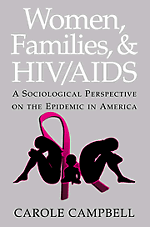Crossref Citations
This Book has been
cited by the following publications. This list is generated based on data provided by Crossref.
Melchior, Lisa A.
Hughes, Chi
Brown, Vivian B.
and
Huba, G. J.
2001.
Practical Issues in Evaluating a Self-Structured Psychosocial and Medical Support Program for Women with HIV/AIDS: PROTOTYPES WomensLink, a Community-Based Organization.
Drugs & Society,
Vol. 16,
Issue. 1-2,
p.
163.
Bancroft, Angus
2001.
Globalisation and HIV/AIDS: Inequality and the boundaries of a symbolic epidemic.
Health, Risk & Society,
Vol. 3,
Issue. 1,
p.
89.
Spirig, Rebecca
2002.
In Invisibility and Isolation: The Experience of HIV-Affected Families in German-Speaking Switzerland.
Qualitative Health Research,
Vol. 12,
Issue. 10,
p.
1323.
Leslie, Michelle Burden
Stein, Judith A.
and
Rotheram-Borus, Mary Jane
2002.
The Impact of Coping Strategies, Personal Relationships, and Emotional Distress on Health-Related Outcomes of Parents Living with Hiv or Aids.
Journal of Social and Personal Relationships,
Vol. 19,
Issue. 1,
p.
45.
Kmita, G.
Baranska, M.
and
Niemiec, T.
2002.
Psychosocial intervention in the process of empowering families with children living with HIV/AIDS--a descriptive study.
AIDS Care,
Vol. 14,
Issue. 2,
p.
279.
Friedman, S. R.
Flom, P. L.
Kottiri, B. J.
Neaigus, A.
Sandoval, M.
Fuld, J.
Curtis, R.
Zenilman, J. M.
and
Des Jarlais, D. C.
2002.
Consistent condom use among drug-using youth in a high HIV-risk neighbourhood.
AIDS Care,
Vol. 14,
Issue. 4,
p.
493.
Squire, Corinne
2003.
Can an HIV-positive Woman Find True Love?: Romance in the Stories of Women Living with HIV.
Feminism & Psychology,
Vol. 13,
Issue. 1,
p.
73.
Ksobiech, Kate
2004.
Assessing and improving needle exchange programs: gaps and problems in the literature.
Harm Reduction Journal,
Vol. 1,
Issue. 1,
Jones, Jenny
2004.
Permanency Planning for HIV/AIDS Affected Children.
Journal of Human Behavior in the Social Environment,
Vol. 9,
Issue. 1-2,
p.
57.
D’Cruz, Premilla
2005.
The influence of HIV concordance and discordance on marital life.
International Social Work,
Vol. 48,
Issue. 5,
p.
581.
Arend, Elizabeth D.
2005.
The Politics of Invisibility.
Journal of Homosexuality,
Vol. 49,
Issue. 1,
p.
97.
Dworkin, Shari L.
and
O'Sullivan, Lucia
2005.
Actual versus desired initiation patterns among a sample of college men: Tapping disjunctures within traditional male sexual scripts.
The Journal of Sex Research,
Vol. 42,
Issue. 2,
p.
150.
Dworkin, Shari L.
2005.
Who is epidemiologically fathomable in the HIV/AIDS epidemic? Gender, sexuality, and intersectionality in public health.
Culture, Health & Sexuality,
Vol. 7,
Issue. 6,
p.
615.
Otutubikey Izugbara, C
2005.
‘Ashawo suppose shine her eyes’: Female sex workers and sex work risks in Nigeria.
Health, Risk & Society,
Vol. 7,
Issue. 2,
p.
141.
UNGER, HELLA VON
and
COLLINS, PAMELA Y.
2005.
Transforming the Meaning of HIV/AIDS in Recovery from Substance Use: A Qualitative Study of HIV-Positive Women in New York.
Health Care for Women International,
Vol. 26,
Issue. 4,
p.
308.
Jones, Jenny L.
2005.
The Prevalence of HIV Among Substance-Abusing African-American Women: A Qualitative Investigation.
Stress, Trauma, and Crisis,
Vol. 8,
Issue. 2-3,
p.
131.
Bulman, Donna E.
2005.
A constructivist approach to HIV/AIDS education for women within the Maritime Provinces of Canada.
International Journal of Lifelong Education,
Vol. 24,
Issue. 6,
p.
475.
Pinto, Rogério M.
and
McKay, Mary M.
2006.
Lessons Learned from African American Women about Participation in a Family-Based HIV Prevention Program.
Families in Society: The Journal of Contemporary Social Services,
Vol. 87,
Issue. 2,
p.
285.
Kyomugisha, Florence G.
2006.
HIV, African American women, and high risk in heterosexual relationships.
Journal of African American Studies,
Vol. 10,
Issue. 2,
p.
38.
Izugbara, Chimaraoke O.
2007.
Constituting the Unsafe: Nigerian Sex Workers' Notions of Unsafe Sexual Conduct.
African Studies Review,
Vol. 50,
Issue. 3,
p.
29.



